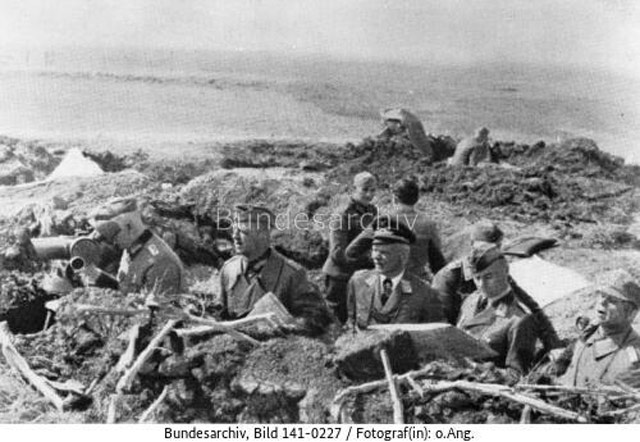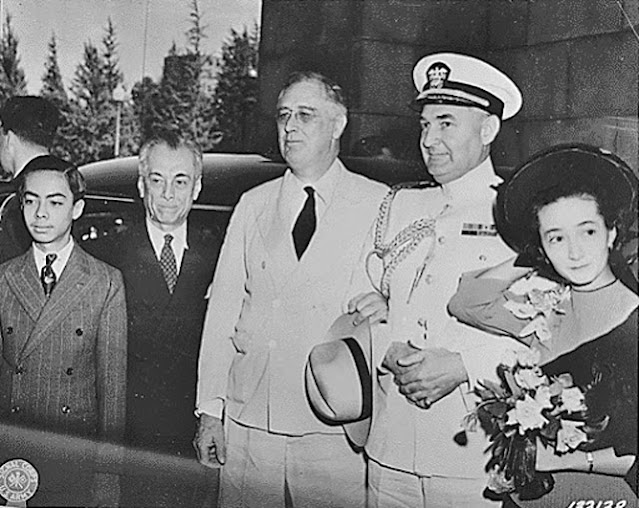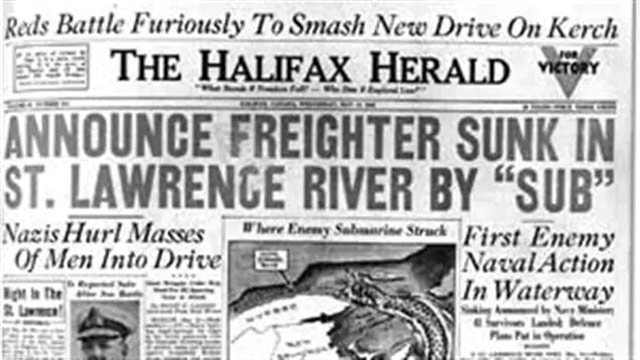Wednesday 13 May 1942
 |
| The U.S. Navy aircraft carrier USS Hornet (CV-8) steaming in the Coral Sea area, 13 May 1942. Photographed from USS Enterprise (CV-6). Naval History and Heritage Command 80-G-16430. |
Battle of the Pacific: Admiral William "Bull" Halsey turns his Task Force 16 north at Efate on 13 May 1942 to defend Nauru and Ocean Island, which the US knows from intercepted Japanese communications are the next Japanese objective. The Japanese have postponed Operation RY, the invasion of those two islands, until 17 May and have no aircraft carriers of their own to cover the landings due to losses at the Battle of the Coral Sea. It is Fleet Admiral Chester Nimitz's hope that simply seeing US carriers USS Enterprise and Hornet there will convince the Japanese to abandon the invasions altogether, at least for the time being.
USS Drum (SS-228), on her first patrol out of Pearl Harbor, torpedoes and sinks 5356-ton Japanese freighter Shonan Maru northeast of Mikimoto, Honshu, Japan.
RAAF Hudson bombs attack and sink naval auxiliary ship Taifoku Maru off Ambon, Maluku Islands, Dutch West Indies (Indonesia).
Japanese 5268-ton ocean liner Nagasaki Maru hits a mine and sinks off Nagasaki. There are 39 deaths.
Battle of the Indian Ocean: The Chinese 6th Division retreats across the Salwen River and proceeds to Kengtun in Burma.
 |
| Colonel-General Erich von Manstein, Luftwaffe Colonel-General Wolfram Freiherr von Richthofen, and Colonel Torsten Christ in the trenches/observation post at a briefing in the Crimea, May 1942 (Federal Archive Image 141-0227). |
Eastern Front: The Red Army advance north and south of Kharkov slows dramatically on 13 May. German General Paulus of Sixth Army receives three full-strength divisions as reserves and they are enough to prevent a Soviet breakthrough to Kharkov itself. The Red Army thrust to the south of the city gains some ground, but those troops have no strategic objectives except closing the pincer west of Kharkov - and that can't happen if the northern advance stalls, and that advance is lagging. The Red Army units all along the front lines are taking heavy casualties and losing strength rapidly, but Stalin is pouring fresh troops into the breakout attempts to maintain momentum.
Hitler is watching the situations in Crimea and around Kharkov closely. The situation becomes a great opportunity for Hitler to play warlord with the Luftwaffe, which is a little unusual for him since he prefers to control army units. While the two battles are close geographically, they are separated by the Sea of Azov and may as well be at opposite ends of the 2000-mile front. Hitler finetunes the Luftwaffe's impact in both theaters. He moves ground-attack units from Crimea to Kharkov, but refuses to move the bulk of 8th Air Corps (Fliegerkorps VIII) until victory at Kerch is assured.
At Fuhrer Headquarters in East Prussia, General Franz Halder writes in his war diary:
In Sixth Army sector, heavy attacks south and northeast of Kharkov, supported by several hundred tanks. Serious penetrations. Counter attack by 23rd (Panzer) and Third (Panzer) Divisions east of Kharkov. Grave crisis south of Kharkov (131st Division).
As Halder notes, the real danger is south of Kharkov, with the northern Red Army thrust gaining much less ground.
 |
| The Indian Express of 13 May 1942 headlines the German offensive in Crimea. |
Here we get into subtleties of strategy that can be difficult to convey, but this is very important for what it reveals about how the war is being conducted at Fuhrer Headquarters. In effect, the Luftwaffe now is tasked with serving as mobile artillery for Fliegerkorps IV at Kharkov while maintaining its overpowering bombing and air-superiority roles for Fliegerkorps VIII in Crimea. Its strength is split between the two battles along tactical lines, or more accurately put, skewed. The Luftwaffe generals believe that the air effort should be more balanced between the two battles at all levels to establish dominance and not bifurcated as Hitler has done. Given a choice between the two, the Kharkov battle is more critical and should be the one with a heavy Luftwaffe presence, not Crimea. Hitler, though, thinks he knows best and always has the last word. Luftwaffe General Wolfram von Richthofen in particular has some choice words to say about this.
It's dangerous to try to read someone else's mind, but Hitler has his reasons for wanting Crimea absolutely secured before switching to the more pressing situation at Kharkov. He has somewhat of an obsession with Crimea, which he sees as a future tourist/retirement spot for the Third Reich. Manstein also is one of his favored generals due to the successes in France and Hitler wants him to succeed. Hitler also has been thinking about Crimea all winter long while Kharkov is a new situation, just part of the endless back-and-forth on the main front. Crimea was one of the major unresolved situations from 1941 and Hitler just wants that off the table permanently.
Due to Hitler's interference, the Luftwaffe remains outnumbered around Kharkov at this time despite the piecemeal reinforcements from Crimea. This is somewhat bizarre since the Kharkov battle is absolutely critical to winning the war while Crimea is not (winning at Kharkov and advancing to the Caucasus automatically would win the Crimea campaign as a minor side effect). The Crimea battle is in a subsidiary zone and already is basically won, so why keep the majority of the Luftwaffe effort there? This is the question the Luftwaffe generals are asking.
However, the situation is not drastically affected by Hitler's choices. The Luftwaffe still maintains air superiority in the key Kharkov areas because self-sacrificing fighter crews fly ten or more missions apiece every day (two or three would be a normal full day). Thus, Hitler's misplaced strategy kind of works because of the dedication and exertions of the Luftwaffe pilots (it is well known as the most National Socialist of the three main service branches and its members are willing to go to extreme lengths to make Hitler's projects succeed at its own expense). There are no "Union rules" in the Luftwaffe and it does have the best equipment even if it is overused.
Some Luftwaffe units from other areas of the front also are being sent to Kharkov, but that will take a few days. It is worth pointing out that while Hitler's counterproductive choices can be overcome at this point of the war because of the Wehrmacht's innate strength and dedication, they would not work if the margin of overall power were to alter to the Wehrmacht's disfavor. And we all know how that works out, but let's stick with the here and now.
In Crimea, Soviet opposition is collapsing in the face of General Erich von Manstein's overpowering Operation Trappenjagd. The Red Army hoped to make a stand at a second line (the "Sultanovka Line"), but the German 132nd and 170th Infantry Divisions blow through it in the morning of the 13th with the 22nd Panzer Division close behind. There remains little standing between them and Kerch. Halder notes approvingly in his war diary:
On the Kerch peninsula, the battle appears to have been decided in our favor (more than 40,000 prisoners). What resistance the enemy will able to put up in this eastern part of the peninsula cannot yet be estimated.
It has been a brilliant victory for 11th Army and Manstein.
European Air Operations: Activity remains light on the Channel Front. Four RAF Wellington bombers attempt a raid on Essen, but the target is covered by clouds and no attack is made there. Three of the bombers choose secondary targets such as Mulheim. There are no losses.
Battle of the Atlantic: German auxiliary cruiser/raider Stier (formerly freighter Cairo) has been sailing down the English Channel since 10 May in order to break out into the Atlantic. The British watch the Channel closely, so this is always a trickier route than sailing north around Scotland. The Royal Navy catches wind of the breakout attempt and sends motor torpedo boats (MTBs) to intercept it. A ferocious small-boat action ensues during which the Germans lose two torpedo boats (932-ton Iltis with 118 dead and 923-ton Seeadler with 85 dead) and the British one MTB (32-ton HM MTB 220).
Wolfpack attacks on convoy ON 92 about 675 nautical miles (1250 km)southeast of Cape race continue. U-94 (Kptlt. Werner Hartenstein), on its third patrol out of Lorient, torpedoes and sinks two ships. The first is 4399-ton freighter Batna. There are one death and 41 survivors, who are rescued by British freighter Bury.
U-94 also torpedoes and sinks 4471-ton Swedish freighter Tolken. All 34 crewmen survive, rescued by British freighter Bury.
U-156 (Kptlt. Werner Hartenstein), on its third patrol out of Lorient, torpedoes and sinks 6630-ton British freighter City of Melbourne west of Barbados. There is one death and 86 survivors.
 |
| Dutch freighter Koenjit (formerly Stjerneborg), one of two ships sunk by U-156 on 13 May 1942. |
U-156 also torpedoes and sinks Dutch freighter Koenjit 300 nautical miles (560 km) northeast of Barbados. All 37 crewmen survive. A motor launch (15-ton Letitia Portia) is being carried by Koenjit and also sinks.
U-128 (Kptlt. Ulrich Heyse), on its third patrol out of Lorient, torpedoes and sinks 3491-ton British freighter Denpark far off the coast of Mauretania. There are 21 deaths and 25 survivors, who are rescued by British freighter City of Windsor.
U-162 (FrgKpt. Jürgen Wattenberg), on its second patrol out of Lorient, torpedoes and sinks 7699-ton US tanker Esso Houston 150 nautical miles (280 km) east of Barbados. There are one death and 41 survivors, who are rescued by Norwegian freighter Havprins or reach land in lifeboats.
U-69 (Oblt. Ulrich Gräf), on its eighth patrol out of St. Nazaire, torpedoes and sinks 2606-ton US freighter Norlantic northeast of Caracas, Venezuela. There are seven deaths and 22 survivors, who are rescued by Dutch freighters India and Mississippi and Norwegian freighter Marpesia.
U-506 (Kptlt. Erich Würdemann), on its second patrol out of Lorient, torpedoes and sinks 8862-ton US tanker Gulfpenn in the Gulf of Mexico six miles off the coast of Louisiana. There are 13 deaths and 38 survivors, who are rescued by Honduran freighter Teide.
 |
| U-156 torpedoes and sinks British freighter City of Melbourne on 13 May 1942. |
Battle of the Mediterranean: Norwegian 5062-ton freighter Hav hits a mine and is badly damaged off Port Said, Egypt. The ship is taken in tow and beached, but ultimately is written off. There are two deaths and 36 survivors.
Two separate civilians on Malta report that Axis pilots threw grenades at them. The main current Axis target is Hal Far airfield.
Partisans: An Axis ant-partisan operation in the Balkans, Operation Trio, officially concludes today. The operation is moderately successful in achieving its objectives of clearing out eastern Bosnia of partisans and relieving a besieged Croatian garrison at Rogatica. This operation settles nothing any finality, so it becomes just one in a series of similar actions against the partisans.
Perhaps inevitably, Operation Trio has revealed fundamental divisions within both the Axis and partisan forces. The two sides have begun fighting within themselves along ideological as well as nationalistic, lines. On the Axis side, the Italians complain that their participation has been limited by the Germans in order to prevent them from expanding their zone of influence. On the partisan side, the royalist Chetnik forces have refused to cooperate with the largely communist main partisan forces and have mounted several "coups" in mixed units. The Chetnik coups have resulted in numerous deaths of communists in those units and stoked antagonism within the partisan movement.
The Ustaše are suspicious of a land grab by the Italians, while the Chetniks avoid combat against the Germans but delight in fighting the Ustaše. Many Chetniks join the Italian forces as auxiliaries, while the partisan main forces avoid fighting the Ustaše but have no problem fighting their supposed Chetnik allies. It is all very confusing to outsiders, and reports in the western media reveal a complete misunderstanding of what is actually going on. War correspondents tend to lavish praise on the Chetniks as a powerful anti-Axis force when their role is much murkier, while the communism of the main partisan forces is downplayed.
The end result has been that many partisans have been killed by both the Axis forces and at the hand of other partisans. The Axis have temporarily "recovered" some cities and territory, but the true significance has been the deterioration of internal relations on both sides. A follow-up attack, Trio II, already is in progress. However, it achieves little because the partisans have evacuated the area.
 |
| President Manuel Quezon visits President Franklin Roosevelt in Washington, D.C., 13 May 1942. |
US/Vichy France Relations: The United States and France reach a tentative agreement regarding aircraft carrier Béarn, light cruiser Emile Bertin, and training cruiser Jeanne D'Arc at Martinique, French West Indies. Amiral (Admiral) Georges Robert, High Commissioner of the Republic to the Antilles, agrees to immobilize the ships. As part of the agreement, the Béarn transfers two-thirds of her fuel to a tanker and disables four of her six boilers. The ship also disables some of its weapons. The Vichy government prefers that the ships be sabotaged, but this is not done, at least now.
German Military: Hitler instructs Armaments Ministers Albert Speer to convert three ships (Europa, Potsdam, and Gneisenau) into auxiliary aircraft carriers. He says that it is "entirely out of the question" for surface forces to operate with air protection. The stumbling block is raw materials, which are in short supply. Once those are obtained, the conversions can be completed within a year.
US Military: US troops replace New Zealand troops in Fiji.
The Bureau of Navigation becomes the Bureau of Naval Personnel.
Ford shows the first M4A3 medium tank, later to become famous as the Sherman Tank.
British Military: King George VI is named the Commander in Chief of the British Home Guard.
American Homefront: Boston Braves lefthanded pitcher Jim Tobin hits three consecutive home runs and pitches a complete game to defeat the Chicago Cubs, 6-5, at Braves Field. He is the first Major League pitcher to hit three home runs in a game since 1886.
 |
| The prototype M4A3 Sherman tank, first rolled out by Ford on 13 May 1942. |

No comments:
Post a Comment